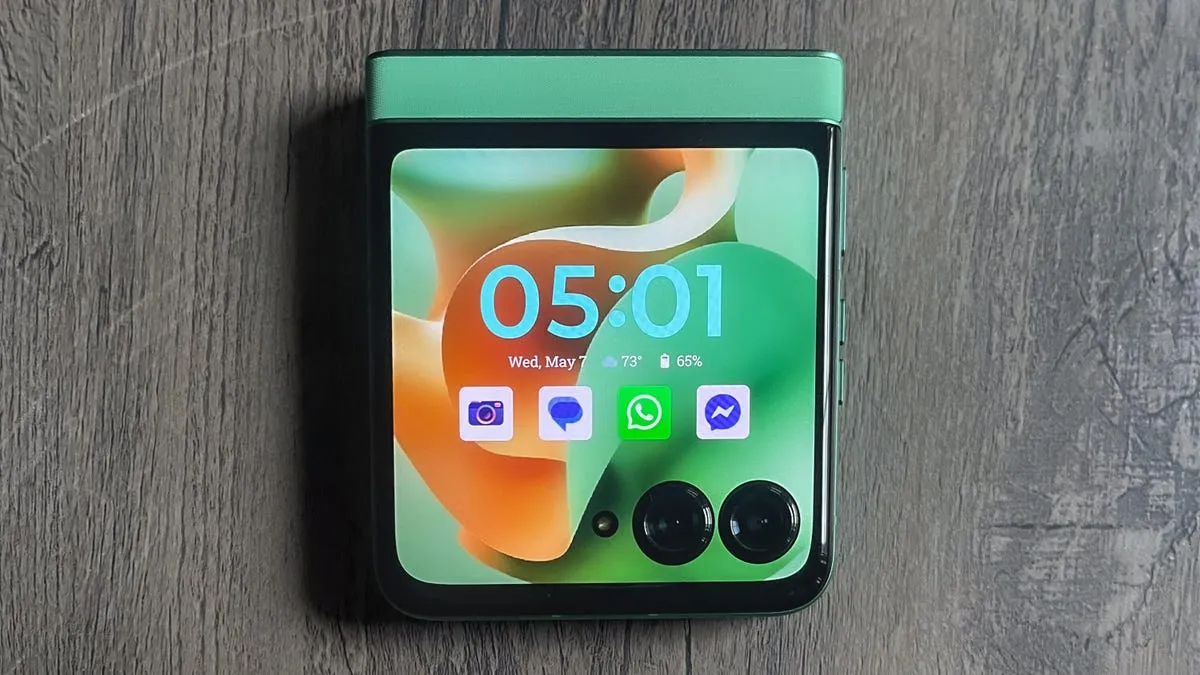
It's truly remarkable how a vivid shade of green can enhance your mood. Upon unboxing the 2025 edition of Motorola's Razr, I was immediately captivated by the phone's striking color, specifically Pantone's Spring Bud. This unique hue strikes a balance between the lightness of mint and the medium tone of flower leaves, making it a standout choice for a flip phone priced at $700.
Although I generally prefer to keep my phone in a case, the Razr's leather-inspired textured back is so appealing that it tempts me to leave it uncovered. The tactile experience is perhaps the most noteworthy aspect of Motorola's new Razr line, further distinguished by options like Alcantara fabric and wood finishes on the more premium $1,300 Razr Ultra. With its bold color palette, a cover screen designed for essential tasks, and a variety of half-folded modes, even the base model feels more expressive than traditional smartphones.
The Motorola Razr provides a refreshing alternative to the typical rectangular smartphones commonly found in the $700 price range. Motorola recognizes that the Razr's eye-catching design is a key factor in attracting new customers; during the phone's unveiling, the company revealed that 25% of its buyers are transitioning from iPhones. While the Razr is priced slightly above value-oriented flagship models like the $650 Samsung Galaxy S24 FE, it remains more affordable than the $800 iPhone 16.
This year's base Razr model is an evolution of last year's design, yet it continues to capture attention with its striking appearance. I have much more testing ahead, but I wanted to share my initial impressions of the Motorola Razr 2025 after a day of use.
Handling the Razr is comfortable, whether it’s open or closed. The cohesive green shade across the phone's body adds a playful touch right from the start. Besides the vibrant green, the Razr is also available in Parfait Pink with a similar leather finish, Gibraltar Sea (blue) featuring a nylon-inspired texture, and Lightest Sky (silver) with an acetate-inspired look.
The Razr's stylish design made it a delightful companion during a dinner outing with friends. I kept it folded while commuting and utilized the cover screen to navigate my subway route to a restaurant in Queens. When it was time to capture some food and street photos, I simply flipped it open. I also took advantage of Moto AI on both screens to look up interesting facts during our meal. One friend even remarked how cute the Razr looked and jokingly expressed a desire to steal it; however, its compact size assured me that wouldn't be happening.
Using the Razr has allowed me to explore capabilities that I can't easily access with similarly priced phones from Samsung and Apple. I often use kickstands for video calls, but with the Razr's hinge, I can position the phone in a half-folded stance, enabling me to have the video call on the upper half while keeping call controls visible on the lower half. In this stand mode, the cover screen can display ambient information like the time, and a simple wave of my hand activates Moto AI for quick inquiries.
As I further test the Motorola Razr, I am keen to evaluate the functionality of the smaller 3.6-inch cover screen. This innovative display acts like a mini phone and significantly differentiates the Razr from other smartphones under $800. You can customize it to run almost every Android app, similar to previous Razr models. Additionally, the Razr serves as the entry-level device for Moto AI, showcasing Motorola's commitment to integrating advanced features in partnership with technologies like Perplexity, Meta's Llama AI, and Microsoft Copilot.
Moto AI not only enhances user experience by offering tailored suggestions based on your screen content but also seamlessly integrates with Google's Gemini to access AI functionalities available in Android 15. With a plethora of innovative ideas packed into Moto AI, I look forward to discovering how these features can optimize my experience with the phone's cover screen.